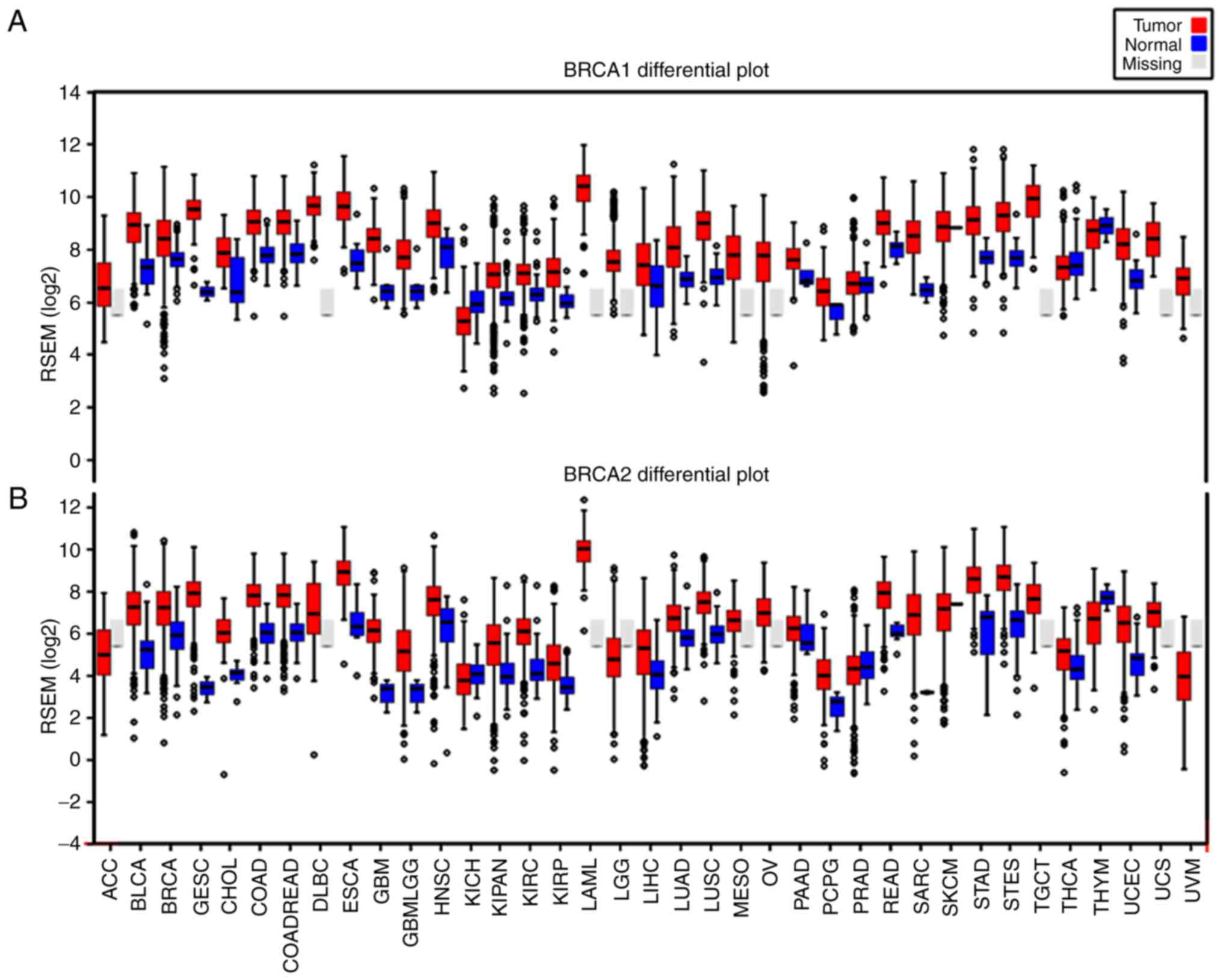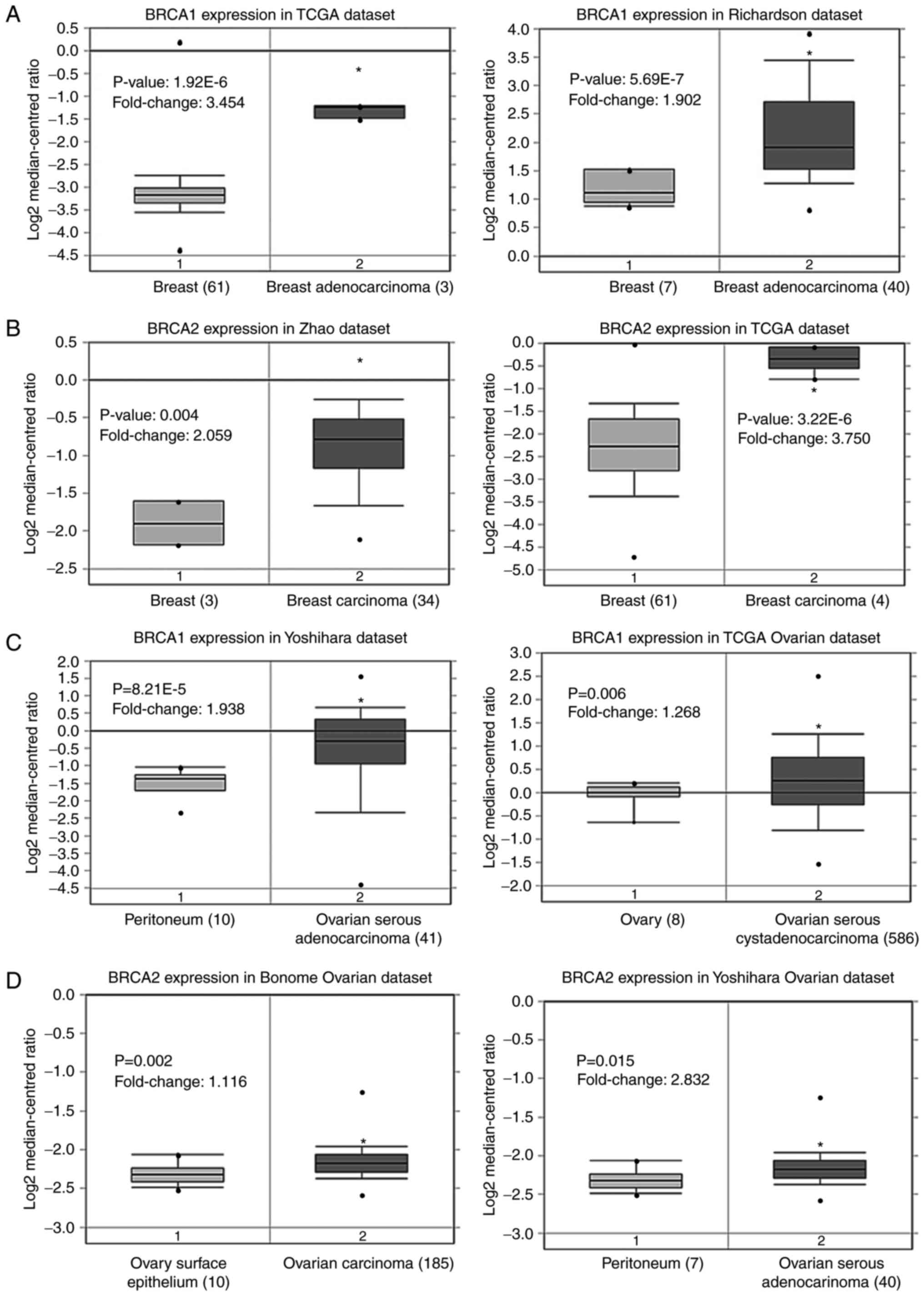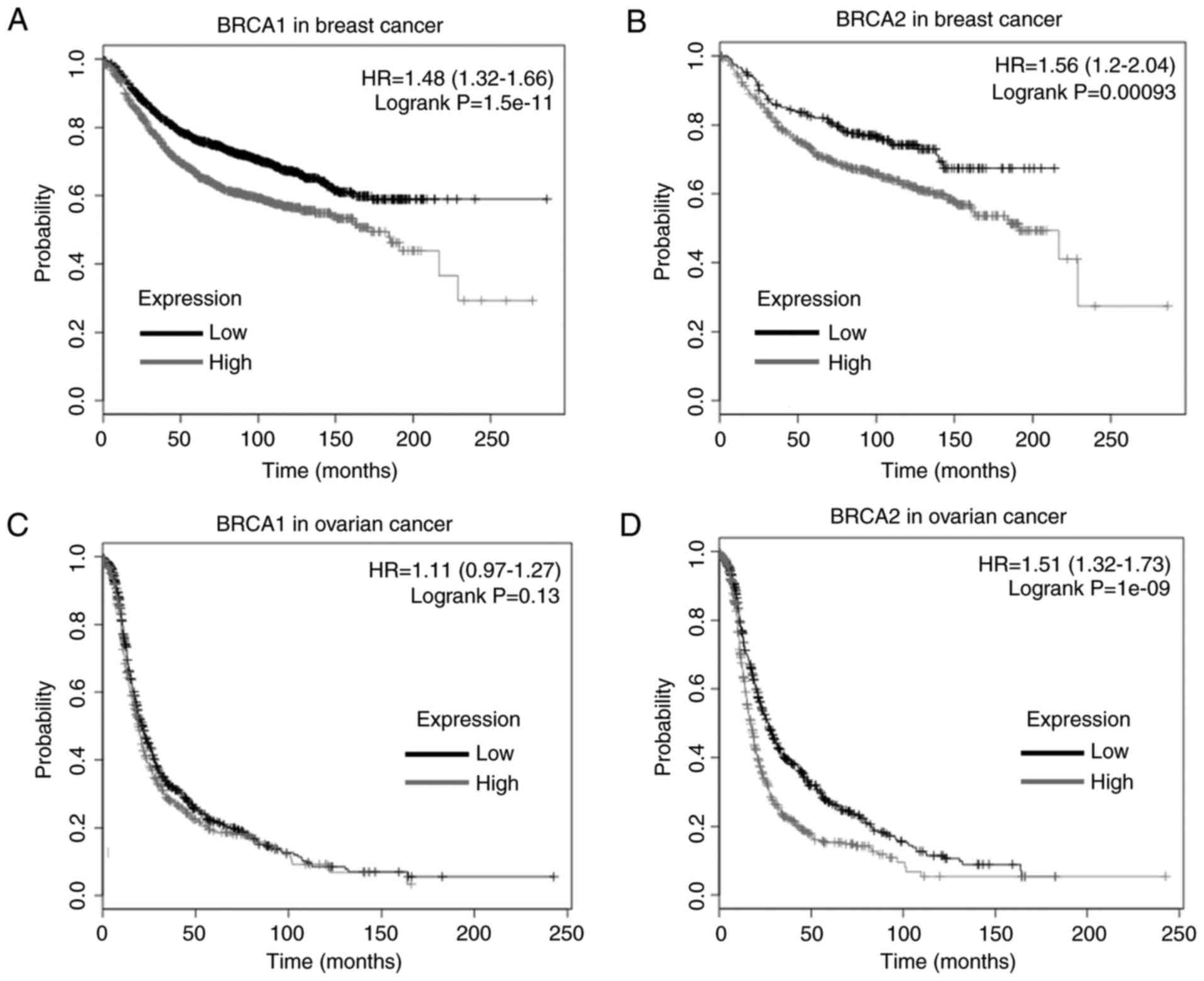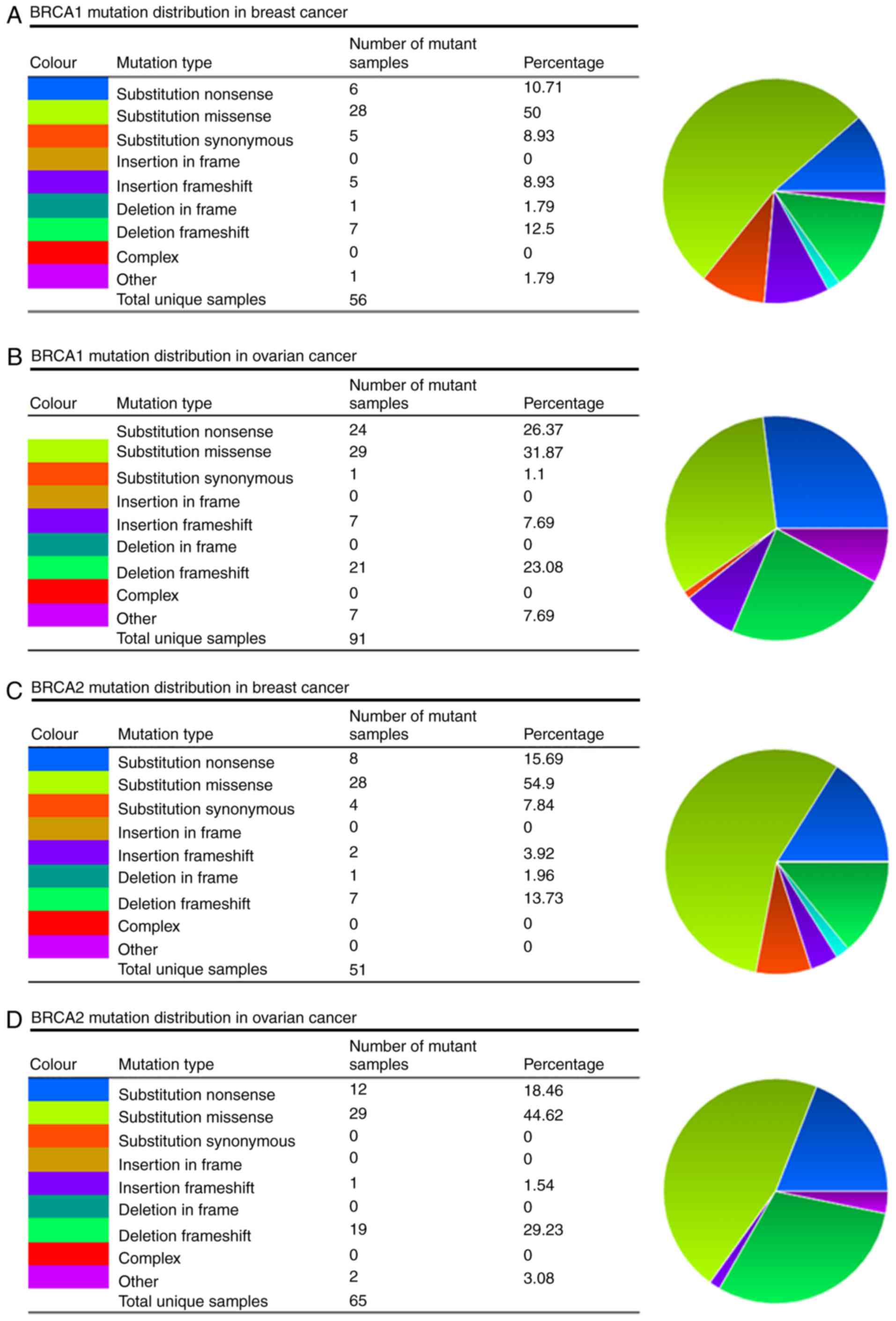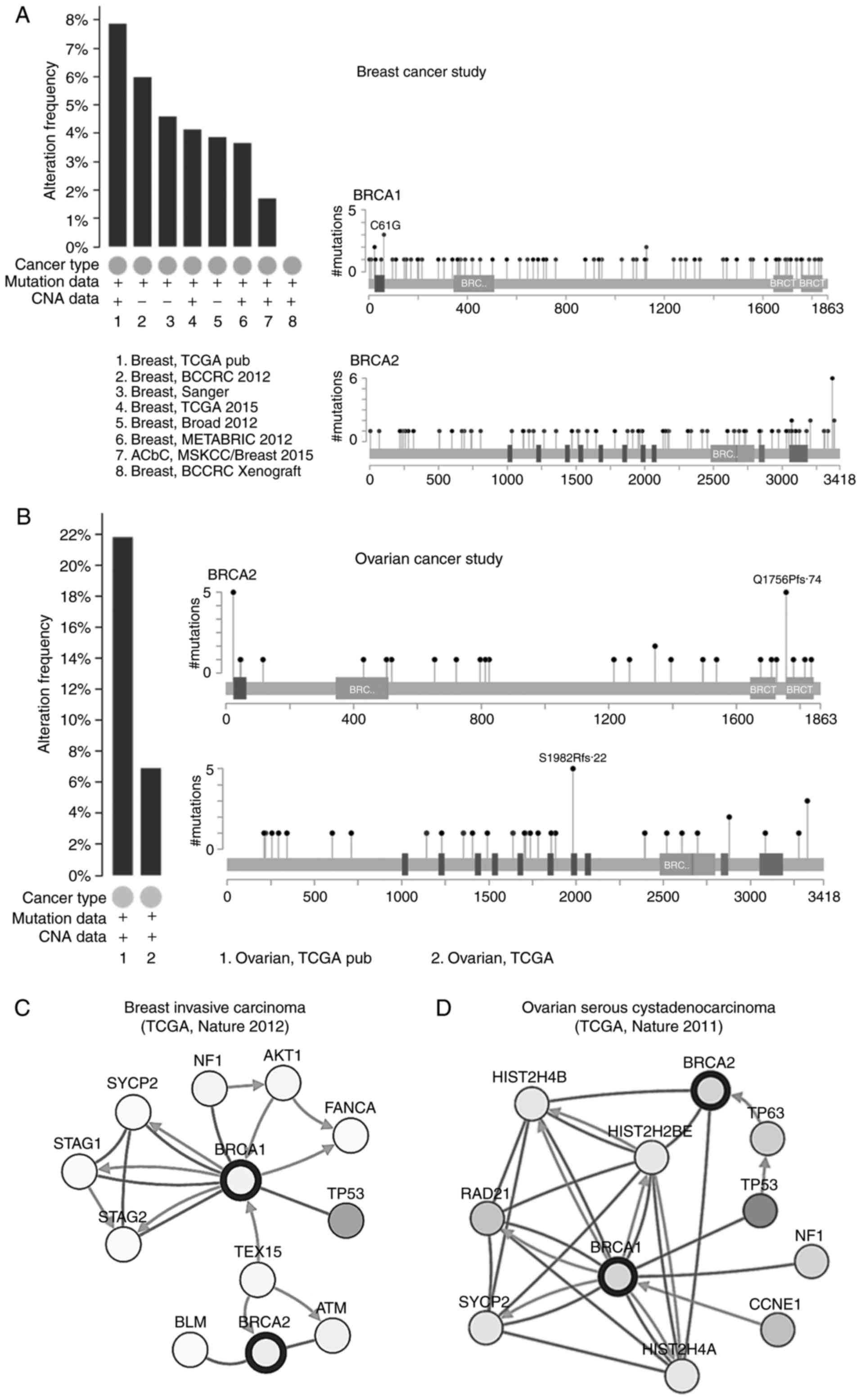Expression and mutations of BRCA in breast cancer and ovarian cancer: Evidence from bioinformatics analyses
- Authors:
- Published online on: September 11, 2018 https://doi.org/10.3892/ijmm.2018.3870
- Pages: 3542-3550
Abstract
Introduction
Breast cancer is the most frequent type of cancer, which is expected to account for 30% of all new cancer diagnoses in women in the United States (1). Ovarian cancer is also a significant contributor to morbidity and mortality rates, ranking as the seventh most common type of cancer and the eighth most common cause of cancer-associated mortality among women (2). The majority of breast cancer cases are a result of gene mutations, particularly mutations in breast cancer 1 (BRCA1) and/or breast cancer 2 (BRCA2), which put individuals at high risk for developing a secondary breast cancer and ovarian cancer (3). The BRCA1 and BRCA2 genes are tumor suppressors. BRCA1 is a large gene, which comprises 24 exons located on chromosome 17 (17q21) and codes for a 1,863-amino acid protein with a zinc-binding Really Interesting New Gene finger motif at the amino terminus and a conserved acidic carboxyl terminal (BRCA1 C-terminal) motif (4,5). The BRCA2 gene is located on chromosome 13 (13q12), which codes for a 3,418-amino acid protein, and shares structural and functional similarities with the BRCA1 protein. It is currently understood that the normal protein products of BRCA1 and BRCA2 genes are important in double-strand DNA repairs by maintaining genomic integrity through RAD51 (6), and they are also involved in pathways associated with homologous recombination (7). However, once either of these genes is mutated or altered, DNA damage may not be repaired properly, likely leading to the occurrence of cancer. In patients with BRCA1 and/or BRCA2 mutations, the risk of breast cancer is significantly higher, compared with that in the general population, and the histological grade is also more aggressive (8-10). In addition, men and women carrying BRCA1 and/or BRCA2 mutations have a 50% chance of passing the mutations on to their children, termed hereditary breast and ovarian cancer syndrome, which is characterized by an increased risk of breast cancer and ovarian cancer (11). Therefore, understanding the expression and mutations of BRCA1/2 in breast cancer and ovarian cancer is urgently required in clinical practice, as is examining the mechanism of tumorigenesis.
Accumulated evidence has demonstrated that the expression levels of BRCAs are altered in several types of human cancer, and multiple mutations have been reported in breast cancer and/or ovarian cancer (12,13). However, the comprehensive analysis of the expression and mutation of BRCA, and its interaction networks is required to provide valuable information for clinical practice and evaluation of its mechanism. The present study mainly investigated the expression levels, mutations and interaction networks of BRCA1 and BRCA2 in breast cancer and ovarian cancer using bioinformatics analyses, which aimed provide insights to reveal the mechanism of BRCA genes ultimately leading to breast or ovarian tumorigenesis.
Materials and methods
FIREHOSE analysis for BRCA1 and BRCA2
The expression profile of BRCA1 and BRCA2 across various human cancer types was examined through the Broad Institute FireBrowse portal (http://firebrowse.org/). On the homepage, ‘BRCA1’ or ‘BRCA2’ were added to the search box and ‘View Expression Profile’ was selected. The boxplots produced showed the expression level of the target gene, with red bars representing tumor samples and blue bars representing normal samples.
Oncomine database analysis
The mRNA levels of BRCA1 and BRCA2 in breast cancer and ovarian cancer tissues were compared with their matched normal tissues using The Cancer Genome Atlas (TCGA) datasets in the Oncomine database (http://www.oncomine.org). The threshold used to obtain the most significant probes of the queried gene for each microarray data included a two-fold difference in expression between cancer and normal tissues with a P-value of <1x10-4. For each gene, the mRNA expression level in three independent datasets was analyzed.
Kaplan-Meier Plotter analysis
The prognostic values of the BRCA1 and BRCA2 genes in breast cancer and ovarian cancer were analyzed using the Kaplan-Meier Plotter (http://kmplot.com/analysis/). Overall, the survival rates of patients with high and low levels of BRCA1 or BRCA2 were shown using a Kaplan-Meier survival plot.
Catalogue Of Somatic Mutations In Cancer (COSMIC) analysis for BRCA1 and BRCA2 mutations
The COSMIC database (http://cancer.sanger.ac.uk/cosmic) was used for the analysis of BRCA1 and BRCA2 mutations. Pie charts were generated for a distribution overview and substitutions on the coding strand in breast cancer and ovarian cancer.
cBioPortal analysis for alteration frequency and interaction network of BRCA1 and BRCA2
The alteration frequencies of BRCA1 and BRCA2 mRNA in breast cancer and ovarian cancer was determined by using the cBioPortal for Cancer Genomics (http://www.cbioportal.org/). All searches and analyses were performed according to the online instructions of cBioPortal (14,15).
Results
BRCA1 and BRCA2 are upregulated in breast cancer and ovarian cancer
The gene expression levels of BRCA1 and BRCA2 were surveyed in 38 cases of human cancer using the TCGA database. The columns in Fig. 1 represent the accurate quantification of gene and isoform expression from the RNA-Seq data. The results showed that higher levels of BRCA1 (Fig. 1A) and BRCA2 (Fig. 1B) transcripts were observed in almost all cancer tissues, compared with the levels in their matched normal tissues. Of note, the BRCA1 and BRCA2 genes exhibited a similar expression pattern in various cancer types, including breast cancer and ovarian cancer (Fig. 1).
Oncomine analysis comparing cancer tissues with normal tissues also showed that the BRCA1 and BRCA2 genes were significantly upregulated in breast cancer and ovarian cancer tissues (Fig. 2A-D) in three independent analyses, compared with corresponding normal tissues (16,17). The results of the Kaplan-Meier analysis revealed that a high expression level of BRCA1 was correlated with a poor survival rate in breast cancer (P=1.51E-11; Fig. 3A) and a high expression level of BRCA2 was correlated with poor survival rates in breast cancer (P=0.00093; Fig. 3B). No significant correlation was found between the expression level of BRCA1 and the survival rate of patients for ovarian cancer (P=0.13; (Fig. 3C), whereas a high expression level of BRCA2 was correlated with poor survival rates in ovarian cancer (P=1.0E-9; Fig. 3D).
BRCA1 and BRCA2 mutations in breast cancer and ovarian cancer
The present study evaluated the mutations of BRCA1/2 using the COSMIC database, and the information regarding the mutations of substitution missense, nonsense, synonymous and insertion frame shift are presented in the pie-chart shown in Fig. 4A-D. In breast cancer and ovarian cancer, the most frequent mutation was substitution missense in the BRCA1/2 genes. In the mutation samples of breast cancer, 50% of the BRCA1 and 54.9% of the BRCA2 mutations were substitution missense (Fig. 4A and C). In ovarian cancer, 31.87% of the BRCA1 and 44.62% of the BRCA2 mutations were substitution missense (Fig. 4B and D). The mutation samples of breast cancer comprised 23.33% G>A, 20.00% G>C and 20.00% G>T substitutions in the BRCA1 coding strand (Fig. 4A), and 22.58% G>C and 19.35% G>A substitutions in the BRCA2 coding strand (Fig. 4C). In the ovarian cancer mutation samples, there were 32.61% G>T and 21.71% G>A substitutions in the BRCA1 coding strand (Fig. 4B), and 23.68% G>T and 21.05 G>A substitutions in the BRCA2 coding strand (Fig. 4D).
The alteration frequencies of BRCA1 and BRCA2 in breast cancer and ovarian cancer were also analyzed using cBioportal. A total of eight studies on breast cancer and two studies on ovarian cancer were included in the database. The results showed that ~2-8% of breast cancer and 6-22% of ovarian cancer clinical samples contained BRCA1 and/or BRCA2 mutations (Fig. 5A and B). In the breast cancer clinical samples, there were 81 mutations observed in BRCA1, 43 of which were missense mutations and 38 were in-frame mutations and truncating; there were 88 mutations in BRCA2, 42 of which were missense mutations and 46 were in-frame mutations and truncating. In ovarian cancer, there were 48 mutations of the BRCA1 gene, only two of which were missense mutations and 46 were in-frame mutations and truncating; there were 46 mutations in BRCA2, five of which were missense mutations and 41 were in-frame mutations and truncating. Several common mutations were observed in BRCA1 (E1346Kfs*20, E23Vfs*17 and Q1756Pfs*74) and BRCA2 (V220Ifs*4, N1784Hfs*2 and S1982Rfs*22) in breast cancer and ovarian cancer, determined by pairwise-analysis (Tables I and II).
Interaction networks of BRCA1 and BRCA2 in breast cancer and ovarian cancer
The interaction networks of BRCA1 and BRCA2 were analyzed using cBioportal (Fig. 5C and D). Among the genes involved in the interaction network, >30% were able to form complexes with BRCA1 and BRCA2 in breast cancer (30.6%) and ovarian cancer (36.5%). In breast cancer, BRCA1 controlled the expression of cyclin-dependent kinase inhibitor 1B (CDKN1B, p27Kip1). The testis expressed 15 gene controlled the state of BRCA1 and BRCA2, respectively. In addition, it was found that the three genes, neurofibromin 1 (NF1), synaptonemal complex protein 2 (SYCP2) and tumor protein 53 (TP53), were involved in breast cancer and ovarian cancer. BRCA1 was able to form complex with the proteins of these three genes, respectively, and also control the state change of SYCP2 in breast cancer and ovarian cancer, which is associated with cell cycle, mitotic and meiosis.
Discussion
In women, BRCA1 or BRCA2 mutations result in a ~40-80% risk of developing breast cancer, and ~11-40% risk of developing ovarian cancer, respectively (18-21). In the present study, the latest evidence of the expression profiles and mutations of BRCA1 and BRCA2 were surveyed using bioinformatics analyses/TCGA data portal and revealed that the BRCA genes were significantly upregulated and mutated in various types of human cancer, including breast cancer and ovarian cancer. Higher mRNA levels of BRCA1 and BRCA2 were observed in tissues samples of 23 types of cancer s, compared with their normal control tissues, including breast cancer and ovarian cancer. This upregulated expression pattern was further validated in three independent RNA-seq datasets. Of note, a positive correlation was identified between the mRNA expression level of the BRCA genes and poor survival rates in breast cancer and ovarian cancer by Kaplan-Meier analysis.
The gene expression levels of BRCA1 and BRCA2 offer a potentially important tool for use in cancer management. A study in lung cancer showed that the BRCA1 gene served as an indicator of chemoresistance, and the reconstitution of wild-type BRCA1 function into lung cancer cells resulted in thousands of fold increases in sensitivity to paclitaxel and vinorelbine (22). Another preclinical study in breast cancer demonstrated the potential of using BRCA1 and BRCA2 dysfunction to predict response to clinical treatment (23). However, another previous study showed that the protein level of BRCA1 exhibited a significant reduction in sporadic breast and ovarian cancer (24,25), which may have been partially due to the different splice variants or localization of the BRCA1 protein. The expression levels of BRCA1 and BRCA2 in human mammary epithelial and cancer cells vary with cell cycle, which are expressed in a cell cycle-dependent manner, peaking at the G1/S boundary (26).
In the present study, ~81 mutations in the BRCA1 gene and 88 mutations in the BRCA2 gene were found in breast cancer samples, and 48 mutations in BRCA1 and 46 mutations in BRCA2 were found in ovarian cancer samples. Of note, three mutations in BRCA1 and three mutations in BRCA2 were observed in both breast cancer and ovarian cancer, which indicated that the effects of these mutations may be common in breast cancer and ovarian cancer. In addition, the common mutations in BRCA1 and BRCA2 were frame-shift deletions, and are known to be oncogenic (27).
It is well known that BRCA1 and BRCA2 are involved in DNA repair, cell cycle checkpoint regulation and transcription (28), and these processes are dictated through crosstalk with a network of proteins. It is now clear that the BRCA1 and BRCA2 proteins co-localize with RAD51 complexes on mitotic and meiotic chromosomes following exposure to ionizing radiation or hydroxyurea (7,29). Certain other proteins have been reported to interact with BRCA1, including ataxia telangiectasia mutated (ATM)/ATM-related kinase, checkpoint kinase 2, and aurora A protein kinase, to regulate cell cycle progression (30). In the present study, three genes (NF1, SYCP2 and TP53) were found to be associated with BRCA1 in breast cancer and ovarian cancer. NF1 is a tumor suppressor gene, which comprises 60 exons coding for the protein neurofibromin, which is associated with neurofibromatosis-noonan syndrome and neurofibromatosis, type 1. Among its associated pathways are the mitogen-activated protein kinase signaling pathway and Ras signaling pathway (31). The NF1 and BRCA1 genes are located in the long arm of chromosome 17, and the involvement of NF1 in breast cancer has been suggested in previous publications (32,33). SYCP2 is a testis-specific human gene with aberrant expression in human papillomavirus-positive cancer (34), and head and neck squamous cell carcinoma (35). In the present study, it was found that BRCA1 was able to form a complex with NF1 and SYCP2, respectively, in breast cancer and ovarian cancer, which suggested that the BRCA1 gene interacts with NF1 and SYCP2 directly or indirectly in cell cycle regulation. However, further investigations are required to discern the complex mechanisms underlying these observations in the future.
In conclusion, the findings of the present study revealed not only the increased expression pattern of the BRCA1 and BRCA2 genes in breast cancer and ovarian cancer, but also provided an understanding on the mutations and interaction networks of these two genes in the types of cancers mentioned. The results also provide significant insight into certain mutations and proteins involved in the interaction network, the roles of which may be common in breast cancer and ovarian cancer.
Acknowledgements
Not applicable.
Funding
This study was financially supported by the Shenzhen Science and Technology Program (Basic Research Project; grant no. JCYJ20170307141840188) and the Innovation and Technology fund of Longhua Shenzhen (grant no. 20150925A0410013).
Availability of data and materials
The data that support the findings of this study are available from The Cancer Genome Atlas: http://cancergenome.nih.gov/.
Authors' contributions
ZW performed the experiments and drafted the manuscript. YZ and QD performed the Oncomine analysis and cBioportal analysis. JZ and HL conceived the study design, obtained funding for the study, and drafted and revised the manuscript. All authors read and approved the final manuscript.
Ethics approval and consent to participate
Not applicable.
Patient consent for publication
Not applicable.
Competing interests
The authors declare that they have no competing interests.
References
|
Siegel RL, Miller KD and Jemal A: Cancer statistics, 2017. CA Cancer J Clin. 67:7–30. 2017. View Article : Google Scholar : PubMed/NCBI | |
|
Shi T, Wang P, Xie C, Yin S, Shi D, Wei C, Tang W, Jiang R, Cheng X, Wei Q, et al: BRCA1 and BRCA2 mutations in ovarian cancer patients from China: Ethnic-related mutations in BRCA1 associated with an increased risk of ovarian cancer. Int J Cancer. 140:2051–2059. 2017. View Article : Google Scholar : PubMed/NCBI | |
|
Eeles RA: Screening for hereditary cancer and genetic testing, epitomized by breast cancer. Eur J Cancer. 35:1954–1962. 1999. View Article : Google Scholar | |
|
Miki Y, Swensen J, Shattuck-Eidens D, Futreal PA, Harshman K, Tavtigian S, Liu Q, Cochran C, Bennett LM, Ding W, et al: A strong candidate for the breast and ovarian cancer susceptibility gene BRCA1. Science. 266:66–71. 1994. View Article : Google Scholar : PubMed/NCBI | |
|
Chapman MS and Verma IM: Transcriptional activation by BRCA1. Nature. 382:678–679. 1996. View Article : Google Scholar : PubMed/NCBI | |
|
Kolinjivadi AM, Sannino V, de Antoni A, Técher H, Baldi G and Costanzo V: Moonlighting at replication forks - a new life for homologous recombination proteins BRCA1, BRCA2 and RAD51. FEBS Lett. 591:1083–1100. 2017. View Article : Google Scholar : PubMed/NCBI | |
|
Chen J, Silver DP, Walpita D, Cantor SB, Gazdar AF, Tomlinson G, Couch FJ, Weber BL, Ashley T, Livingston DM and Scully R: Stable interaction between the products of the BRCA1 and BRCA2 tumor suppressor genes in mitotic and meiotic cells. Mol Cell. 2:317–328. 1998. View Article : Google Scholar : PubMed/NCBI | |
|
Narod SA, Brunet JS, Ghadirian P, Robson M, Heimdal K, Neuhausen SL, Stoppa-Lyonnet D, Lerman C, Pasini B, de los Rios P, et al: Tamoxifen and risk of contralateral breast cancer in BRCA1 and BRCA2 mutation carriers: A case-control study. Hereditary breast cancer clinical study group Lancet. 356:1876–1881. 2000. | |
|
Sakorafas GH and Tsiotou AG: Genetic predisposition to breast cancer: A surgical perspective. Br J Surg. 87:149–162. 2000. View Article : Google Scholar : PubMed/NCBI | |
|
Nicoletto MO, Donach M, De Nicolo A, Artioli G, Banna G and Monfardini S: BRCA-1 and BRCA-2 mutations as prognostic factors in clinical practice and genetic counselling. Cancer Treat Rev. 27:295–304. 2001. View Article : Google Scholar | |
|
Cicero G, De Luca R, Dorangricchia P, Lo Coco G, Guarnaccia C, Fanale D, Calò V and Russo A: Risk perception and psychological distress in genetic counselling for hereditary breast and/or ovarian cancer. J Genet Couns. 26:999–1007. 2017. View Article : Google Scholar : PubMed/NCBI | |
|
Alvarez C, Aravena A, Tapia T, Rozenblum E, Solís L, Corvalán A, Camus M, Alvarez M, Munroe D, Maass A and Carvallo P: Different Array CGH profiles within hereditary breast cancer tumors associated to BRCA1 expression and overall survival. Bmc Cancer. 16:2192016. View Article : Google Scholar : PubMed/NCBI | |
|
Ewald IP, Vargas FR, Moreira MA, Filho CM, da Cunha DR, Ramos JP, Ribeiro PL, Caleffi M, Giuglani R and Ashton-Prolla P: Prevalence of BRCA1 and BRCA2 founder mutations in Brazilian hereditary breast and ovarian cancer families. J Clin Oncol. 26:2008. View Article : Google Scholar | |
|
Gao J, Aksoy BA, Dogrusoz U, Dresdner G, Gross B, Sumer SO, Sun Y, Jacobsen A, Sinha R, Larsson E, et al: Integrative analysis of complex cancer genomics and clinical profiles using the cBio-Portal. Sci Signal. 6:2013. View Article : Google Scholar | |
|
Cerami E, Gao J, Dogrusoz U, Gross BE, Sumer SO, Aksoy BA, Jacobsen A, Byrne CJ, Heuer ML, Larsson E, et al: The cBio cancer genomics portal: An open platform for exploring multidimensional cancer genomics data. Cancer Discov. 2:401–404. 2012. View Article : Google Scholar : PubMed/NCBI | |
|
Zhao H, Langerød A, Ji Y, Nowels KW, Nesland JM, Tibshirani R, Bukholm IK, Kåresen R, Botstein D, Børresen-Dale AL and Jeffrey SS: Different gene expression patterns in invasive lobular and ductal carcinomas of the breast. Mol Biol Cell. 15:2523–2536. 2004. View Article : Google Scholar : PubMed/NCBI | |
|
Richardson AL, Wang ZC, De Nicolo A, Lu X, Brown M, Miron A, Liao X, Iglehart JD, Livingston DM and Ganesan S: X chromosomal abnormalities in basal-like human breast cancer. Cancer Cell. 9:121–132. 2006. View Article : Google Scholar : PubMed/NCBI | |
|
Mavaddat N, Peock S, Frost D, Ellis S, Platte R, Fineberg E, Evans DG, Izatt L, Eeles RA, Adlard J, et al: Cancer risks for BRCA1 and BRCA2 mutation carriers: Results from prospective analysis of EMBRACE. J Natl Cancer Inst. 105:812–822. 2013. View Article : Google Scholar : PubMed/NCBI | |
|
Chen S and Parmigiani G: Meta-analysis of BRCA1 and BRCA2 penetrance. J Clin Oncol. 25:1329–1333. 2007. View Article : Google Scholar : PubMed/NCBI | |
|
Blay P, Santamaria I, Pitiot AS, Luque M, Alvarado MG, Lastra A, Fernández Y, Paredes A, Freije JM and Balbín M: Mutational analysis of BRCA1 and BRCA2 in hereditary breast and ovarian cancer families from Asturias (Northern Spain). BMC Cancer. 13:2432013. View Article : Google Scholar : PubMed/NCBI | |
|
Petrucelli N, Daly MB and Feldman GL: Hereditary breast and ovarian cancer due to mutations in BRCA1 and BRCA2. Genet Mod. 12:245–259. 2010. View Article : Google Scholar | |
|
Taron M, Rosell R, Felip E, Mendez P, Souglakos J, Ronco MS, Queralt C, Majo J, Sanchez JM, Sanchez JJ and Maestre J: BRCA1 mRNA expression levels as an indicator of chemoresistance in lung cancer. Hum Mol Genet. 13:2443–2449. 2004. View Article : Google Scholar : PubMed/NCBI | |
|
Farmer H, McCabe N, Lord CJ, Tutt AN, Johnson DA, Richardson TB, Santarosa M, Dillon KJ, Hickson I, Knights C, et al: Targeting the DNA repair defect in BRCA mutant cells as a therapeutic strategy. Nature. 434:917–921. 2005. View Article : Google Scholar : PubMed/NCBI | |
|
Kim MC, Choi JE, Lee SJ and Bae YK: Coexistent loss of the expressions of BRCA1 and p53 predicts poor prognosis in triple-negative breast cancer. Ann Surg Oncol. 23:3524–3530. 2016. View Article : Google Scholar : PubMed/NCBI | |
|
Ju LL, Zhao CY, Ye KF, Yang H and Zhang J: Expression and clinical implication of Beclin1, HMGB1, p62, survivin, BRCA1 and ERCC1 in epithelial ovarian tumor tissues. Eur Rev Med Pharmacol Sci. 20:1993–2003. 2016.PubMed/NCBI | |
|
Rajan JV, Wang M, Marquis ST and Chodosh LA: Brca2 is coordinately regulated with Brca1 during proliferation and differentiation in mammary epithelial cells. Proc Natl Acad Sci USA. 93:13078–13083. 1996. View Article : Google Scholar : PubMed/NCBI | |
|
Cancer Genome Atlas Network: Comprehensive molecular portraits of human breast tumours. Nature. 490:61–70. 2012. View Article : Google Scholar : PubMed/NCBI | |
|
Welcsh PL and King MC: BRCA1 and BRCA2 and the genetics of breast and ovarian cancer. Hum Mol Genet. 10:705–713. 2001. View Article : Google Scholar : PubMed/NCBI | |
|
Parvin S, Islam MS, Al-Mamun MM, Islam MS, Ahmed MU, Kabir ER and Hasnat A: Association of BRCA1, BRCA2, RAD51, and HER2 gene polymorphisms with the breast cancer risk in the Bangladeshi population. Breast Cancer. 24:229–237. 2016. View Article : Google Scholar : PubMed/NCBI | |
|
Christou CM and Kyriacou K: BRCA1 and its network of interacting partners. Biology. 2:40–63. 2013. View Article : Google Scholar : PubMed/NCBI | |
|
Brems H, Beert E, de Ravel T and Legius E: Mechanisms in the pathogenesis of malignant tumours in neurofibromatosis type 1. Lancet Oncol. 10:508–515. 2009. View Article : Google Scholar : PubMed/NCBI | |
|
Campos B, Balmaña J, Gardenyes J, Valenzuela I, Abad O, Fàbregas P, Volpini V and Díez O: Germline mutations in NF1 and BRCA1 in a family with neurofibromatosis type 1 and early-onset breast cancer. Breast Cancer Res Treat. 139:597–602. 2013. View Article : Google Scholar : PubMed/NCBI | |
|
Madanikia SA, Bergner A, Ye X and Blakeley JO: Increased risk of breast cancer in women with NF1. Am J Med Genet A. 158A:3056–3060. 2012. View Article : Google Scholar : PubMed/NCBI | |
|
Masterson L, Sorgeloos F, Winder D, Lechner M, Marker A, Malhotra S, Sudhoff H, Jani P, Goon P and Sterling J: Deregulation of SYCP2 predicts early stage human papillomavirus-positive oropharyngeal carcinoma: A prospective whole transcriptome analysis. Cancer Sci. 106:1568–1575. 2015. View Article : Google Scholar : PubMed/NCBI | |
|
Pannone G, Santoro A, Papagerakis S, Lo Muzio L, De Rosa G and Bufo P: The role of human papillomavirus in the pathogenesis of head & neck squamous cell carcinoma: An overview. Infect Agent Cancer. 6:42011. View Article : Google Scholar |



